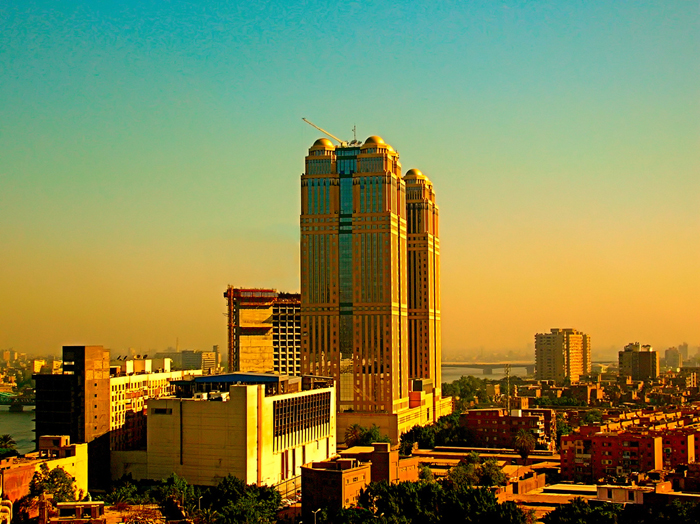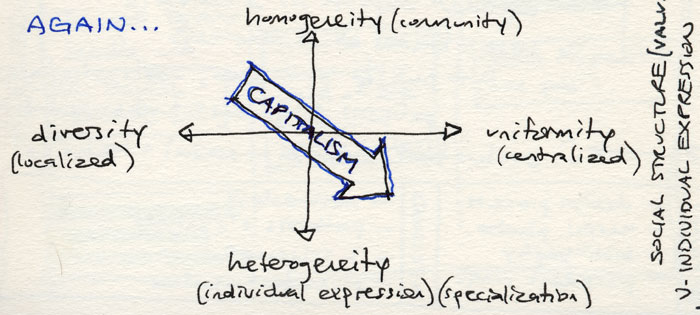World Cities and Global Capitalism

a view of Cairo, Egypt; photo by Giampaolo Macorig, some rights reserved
This paper first appeared in Calx, Issue 1 (Fall 2007), a student publication of the College of Design, Architecture, Art and Planning at the University of Cincinnati. It was adapted from a critical response to two readings completed for a Contemporary Anthropological Theory course. Both readings are from World Cities Beyond the West, edited by Josef Gugler (2004).
This essay briefly discusses a few dimensions of the complex interrelationship between global capitalism and "world cities." It then explores parallels to conditions in Cincinnati, Ohio, and finally posits a role for architects and designers in responding to contemporary conditions.
On World Cities, Capitalism, and Diversity
Josef Gugler's criteria for a "world city," outlined in his Introduction to World Cities Beyond the West, are primarily economic. The indicators he uses include the net service value of major firms, gross annual revenue, stock market capitalizations, and international flights [1]. The very term "world city" is therefore connected to global capitalism, and thus provides an excellent context for an examination of its effects.
The debate over the effects of global capitalism center (roughly) around two competing views: one that sees economic globalization as an overpowering juggernaut razing locality and uniqueness and leaving mass-produced homogeneity in its wake; and the other that sees globalization as a bearer of a bounty of new goods and ideas which localities borrow selectively and adapt, creating heterogeneity and pastiche. Such analysis, however, is fairly one-dimensional. A useful distinction can be made between uniformity (the large-scale systemic similarities) and homogeneity (sameness in appearance or composition) [2]. This distinction allows simultaneous recognition of the broad processes of economic assimilation and the local processes of adaptation. Thus global capitalism tends toward uniformity and heterogeneity: as underlying forces become more unified, people react by manufacturing difference and constructing identity.

One of Gugler's three conclusions is that world cities are "extraordinarily diverse," which appears to run counter to the uniformity/heterogeneity argument. The forms of diversity include (a) history, (b) spatial and architectural patterns (manifestations of history), (c) size of economy (ranging from poor to wealthy), (d) niche in regional economy, (e) political context, and (f) racial/ethnic/religious diversity. Interestingly, most (if not all) of these can be categorized as contextual diversity (as opposed to functional diversity). That is to say, the diversity is not a result of global capitalism, nor a reflection of a variety of livelihood, subsistence, or production strategies. Rather, it is a reflection of the diverse social and historical conditions that existed prior to the rise of the capitalist regime. The remnant diversity (heterogeneity) therefore says nothing about the underlying uniformity.
If anything, the emerging conditions in these world cities evidence the uniformity imposed by global capitalism. Terms like inequality and market niche attest to its structural influence. Janet Salaff's examination of Singapore [3] details the social and cultural changes that resulted from (or precipitated?) its embrace. They include: specialized education, decreasing dependence on community (and especially on kin), and increasing dependence on the government (and on the market) [4]. These changes could be seen as a departure from more traditional subsistence strategies toward a more "modern" approach — one that comports with the requirements of exchange in global markets. Importantly, the increased dependence on markets is connected to gross wealth disparities, as discussed below. Indeed, common among all world cities are expanding differences between rich and poor [5].
On Dependence, Vulnerability, and Inequality
Connections between (a) dependence on the global economy, (b) increasing vulnerability of local economies, and (c) increasing social stratification are made several times in these readings. The relationship between dependence and vulnerability is fairly straightforward: "The impact of the global economy, in boom and in crash, is felt most dramatically in world cities heavily dependent on foreign investments, exports, and tourism" [6]. This impact is often made worse by lack of public support systems.
The connection between dependence on the global economy and deepening inequality is not necessarily as clear, although it is mentioned several times by Gugler [7]. It is a significant connection, however, because poverty is often attributed to internal factors (deficient entrepreneurial and management skills and overpopulation — euphemisms for lack of motivation and intelligence), when in fact external factors (in particular, Western impact, both colonial and economic) play a major role [8].
Both dependency and inequality in world cities are arguably related to rapid urbanization — specifically, to the movement of the poor [9] from rural areas to urban centers [10]. This migration can be seen as a movement away from non-market livelihood strategies involving a higher degree of autonomy (e.g., growing one's own food) toward market-based strategies involving a higher degree of dependency and often associated with social changes like those described by Salaff (above).
Regarding poverty in Cairo, Abu-Lughod states: "One must ask why the concerted efforts at modernization [...] have not only failed to reduce the proportion of Egyptians and Cairenes living in poverty, but have actually contributed to greater inequality" [11]. Insofar as modernization is related to global capitalism [12], there are many possible answers to this question: (a) capitalism rewards access to resources with greater access to resources; (b) investments are targeted toward increasing market activity (and especially toward accommodating international businessmen) and so have failed to improve the living environment of the poorest people [13]; (c) risks in capitalist economies are born disproportionately by the poor (e.g., environmental problems) [14]; (d) growing markets tend to erode community-based livelihood strategies that are often vital for making ends meet in poor communities [15]; etc. A demonstrable correlation therefore exists between global capitalism, uniformity, increasing dependency, deepening poverty, and increasing inequalities.
On Local Implications and the Role of the Architect
While Cincinnati is by no means a world city, and while Over-the-Rhine (OTR) is not suffering from overpopulation — quite the contrary, it is notably underpopulated — OTR is certainly suffering from poverty, inadequate infrastructure, and ineffectual administration: three characteristics of "mega cities" as described by Abu-Lughod [16].
Two lessons can be learned from Cairo in regards to development projects aimed at mitigating the above problems. First: we see in Cairo the difficulty planners have in implementing their plans. It is hard (if not impossible) to force growth along certain predetermined paths. It is also fairly counter-productive, because resources are often expended for projects that are ill-used or ultimately abandoned, while in the mean time people are living without basic necessities.
Second: OTR is similar to Cairo in terms of its three competing interests: preservation, development, and equity. OTR has recently been named one of "America's 11 Most Endangered Places" by the National Trust for Historic Preservation [17]. Local development interests such as the Cincinnati Center City Development Corporation (3CDC) want to "revitalize" (i.e., gentrify) the area [18]. And many local residents and nonprofit groups seek to remediate the issues of poverty and racism. It is not promising to note that in Cairo, "the tendency has been for all improvements [...] to reduce the spaces available for informal production and low-cost housing" [19].
One suspects that a higher degree of community involvement is necessary for development projects to avoid such uniforming tendencies (and associated impacts) — and further, that greater participation ultimately requires (and perhaps promotes) changes in political processes and social organization. This reveals a role for architects in helping to solve — or at least engage with — the complex problems associated with urban conditions, and perhaps to spark social change more generally, by critically engaging the process of design. The architect must be aware of power relations present in the act of design, the myriad effects of architectural interventions on multiple constituencies (most of whom are not "clients" per se), and the economic forces that act upon these constituencies.
Ultimately the architect cannot avoid assuming a position — whether critical or unconscious — vis-à-vis economic globalization in light of its role as a primary force defining urban areas in general, and world cities in particular.
[1] Gugler, Josef. 2004. World Cities Beyond the West: Globalization, Development and Inequality. Cambridge: Cambridge University Press, p. 6-7.
[2] This distinction borrowed from Bayly, C. A. 2004. The Birth of the Modern World: 1780-1914. Oxford: Blackwells. This distinction allows simultaneous recognition of the broad processes of globalization and local adaptation and diversity. I argue elsewhere that global capitalism tends toward uniformity and heterogeneity: as underlying forces become more unified, people react by manufacturing difference and constructing identity.
[3] Salaf, Janet. 2004. "Singapore: Forming the Family for a World City." In World Cities Beyond the West: Globalization, Development and Inequality. Ed. by Josef Gugler. Cambridge: Cambridge University Press, p. 240-267.
[4] For more on the relationship between the capitalist economy and the welfare state see: Habermas, Jürgen. 1984. "The New Obscurity: The Crisis of the Welfare State and the Exhaustion of Utopian Energies." In The New Conservatism: Cultural Criticism and the Historians' Debate. Trans. and ed. by Shierry Weber Nicholsen. Cambridge, Mass.: MIT Press, 1989.
[5] Gugler 2004.
[6] Ibid., p. 15.
[7] E.g., see p. 123, 144, 147.
[8] Gugler 2004.
[9] "The poor" is a problematic term that tends to essentialize a diverse group of people. It also ignores variation in types and effects of poverty in different areas, especially between county and city. The author advises skepticism.
[10] See the Worldwatch Institute for current statistics (www.worldwatch.org).
[11] Abu-Lughod, Janet L. 2004. "Cairo: Too May People, Not Enough Land, Too Few Resources." In World Cities Beyond the West: Globalization, Development and Inequality. Ed. by Josef Gugler. Cambridge: Cambridge University Press, p. 144.
[12] Again, this is by no means an incontrovertible relationship. Briefly, it can be said that modernization by definition necessitates industrial production, which paves the way for global capitalism by providing mechanisms of mass production, including technological capacity and specialization, as well as markets for mass-produced goods.
[13] Abu-Lughod 2004, p. 147.
[14] For an excellent discussion of risk see Beck, Ulrich. 1999. World Risk Society. Cambridge: Polity Press; Malden, Mass.: Blackwell.
[15] For a case study regarding such "alternative livelihood strategies," see Halperin, Rhoda H. 1998. Practicing Community: Class, Culture and Power in an Urban Neighborhood. Austin: University of Texas Press.
[16] Abu-Lughod 2004, p. 119.
[17] National Trust for Historic Preservation. 2006. "America's 11 Most Endangered Places: Over-the-Rhine Neighborhood." Available at: http://www.nationaltrust.org/11most/over-the-rhine.html.
[18] Cincinnati Center City Development Corporation (3CDC). 2007. "3CDC Projects Completed or Currently Under Development in Over-the-Rhine." Available at: http://www.3cdc.org/otr/projects.
[19] Abu-Lughod 2004, p. 143.